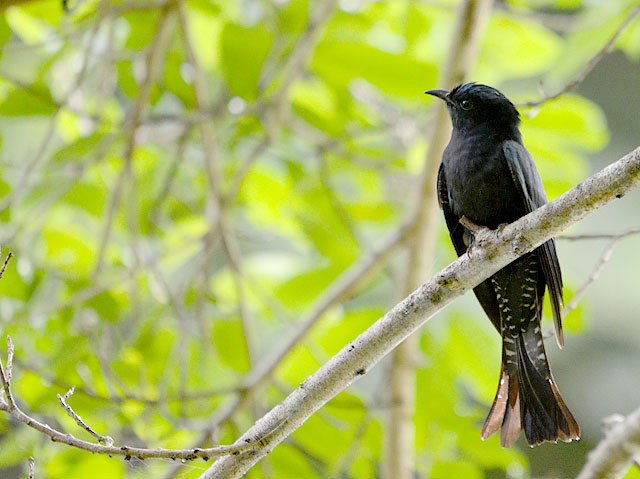I
found myself exploring the foothills of Gunung Bintang in the state of Kedah on
Boxing Day this year. And the weather was surprisingly good with clear blue
skies and plenty of sunshine. The vicinity was alive with the sounds of nature
and as usual, the wilderness provides sanctuary for my wearied soul. The troops
of Agile Gibbons present almost drowned out all the rest with their powerful territorial
calls and for these shy primates that is often the only indication of their
presence.
One
particular call had my undivided attention. It is a series of mournful notes
but owner of the call is anything but mournful. I do not come across the Red-naped
Trogon all that often and this individual was not making it easy for me. The
dense foliage of the canopy hid the bird well and the vocalization was the only
aid I have to locating this stunning forest dweller. Quarter of an hour and a
couple of leech bites later, the trogon shifted position and slight movement
was all that was needed for its location to be revealed. It was a dreadful photographic
attempt but the experience exciting nevertheless.
The
trogons of this birding haven appear to have returned to the forest surrounding
this access road. The movement control order by the government decreased human
activities considerably here and could well be one of the main reasons why I
found myself surrounded by these forest denizens today. As much as I hate to
admit it, human interference regardless of any nature, will have an impact on
the ecosystem. In our absence, Mother Nature thrives. Anyway, the Diard’s
Trogon and Orange-breasted Trogon teased me with fleeting views from the cover
of the forest. Even the commoner Scarlet-rumped Trogon was reluctant to reveal his true beauty today.
His
duller mate was not any much better despite resting on a relatively open perch.
The
two resident forest kingfishers were also up and about. While the Banded
Kingfisher remained out of sight, the Rufous-collared Kingfisher provided a
brief but mesmerizing encounter. She alighted at eye level but unfortunately in
a gloomy part of the forest. Unlike most avian species, she is just as striking
as her male counterpart. I could not recall the last time I came across a female
of this species and this girl certainly brought some cheer after the
frustrating time with the trogons.
A
number of birdwaves swept past me as I slowly ascended the trail. Babblers,
warblers, flycatchers, woodpeckers and sunbirds were the main participants of
this natural phenomenon. Photographic attempts were futile as the birds were
exceptionally active today. All except for a male Black-winged
Flycatcher-Shrike that decided to take a short breather in the midst of all the
chaos.
Fruiting
trees are always a good spot for birds. A small fruiting next to the access
road made me stop to have a better look. A pair of Finsch’s Bulbuls came for a
short feed but they were the only signs of life at the tree for the entire
duration I was there.
I
did not give much thought to the resident Chestnut-naped Forktails that were
darting about today as these birds do not appreciate human presence much. However,
a juvenile decided to momentarily abandon its skittish nature and foraged relatively
close to my position. This species has a tendency to hunt along isolated access
roads and when out the in the open like this, one can truly appreciate the
beauty of the Chestnut-naped Forktail even if it has yet to obtain full adult
plumage.
Well,
we are all familiar with the saying stop and smell the roses but you will not
find any roses here in this hot and humid environment. I hope I am not getting
sentimental with age but while waiting (in vain) for the forktail to show
itself again, this yellow flower did catch my eye.
The
Bushy-crested Hornbill is probably the avian world’s equivalent of the gibbons
here at this site. It occurs in flocks and just like the primates, are vocal by
nature. A flock was yelping away (yup, they do sound somewhat like puppies)
from one of the taller trees and lucky for me, the foliage was sparse enough to
make the shape of the hornbills. They were quite a distance away and the tree,
strongly backlighted.
Years
of birding has moulded me into a patient man and I waited for, hopefully, a change
of fortune. My determination paid off when the flock, consisting of nine
individuals, took flight and headed towards my direction. I also have been
birding long enough to know that things rarely work out exactly how you hoped. When
it comes to forest birding, everything comes down to luck and it certainly had
some for this encounter.
My
best effort of the flying Bushy-crested Hornbills was of this young male. He
was the last one to make it across the valley and my modest photographic setup
had a little more time to capture the moment. There is just something about
hornbills in flight that make them so captivating – even if the species is
mostly shades of brown.
I
had to borrow my better half’s ride for my birding adventure this time as the
battery of my old girl died on me the day before. When it comes to photography,
birds and other wildlife naturally has precedence over everything else. But
vehicles are one of my few other passions in life and you will find a number of
photographs of this nature in my digital archive. And this Kai Concept crossover
wrapped things up for the day.
































